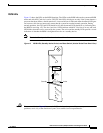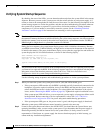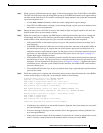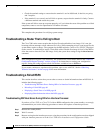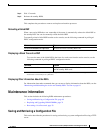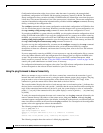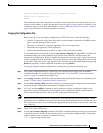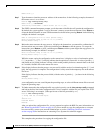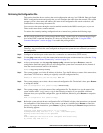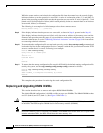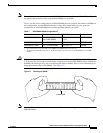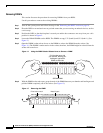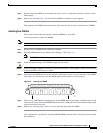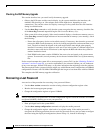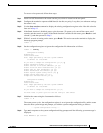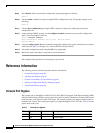
73
Route Switch Processor (RSP8) Installation and Configuration Guide
OL-4920-02
Maintenance Information
Retrieving the Configuration File
This section describes how to retrieve the saved configuration and copy it to NVRAM. Enter privileged
EXEC configuration mode and specify that you will configure the router from the network. The system
prompts you for a host name and address, the name of the configuration file stored on the host, and
confirmation to reboot using the remote file.
You can access the router through a console terminal attached to the RSP8 console port, or you can
Telnet to the router from a remote terminal.
To retrieve the currently running configuration from a remote host, perform the following steps:
Step 1 On the console terminal, the system prompt should display a pound sign (#) to indicate the privileged
level of the EXEC command interpreter. If it does not, follow the steps in the “Using the EXEC
Command Interpreter” section on page 24 to enable the privileged level.
Note Until you retrieve the previous configuration, the router runs from the default configuration in NVRAM.
Therefore, any passwords that were configured on the previous system are not valid until you retrieve
the configuration.
Step 2 Configure an interface port on the router for a connection to a remote host (TFTP server).
Step 3 Use the ping command to verify the connection between the router and the remote host. (See the “Using
the ping Command to Ensure Connectivity” section on page 70.)
Step 4 At the system prompt, use the copy tftp startup-config command and press Return to enter the
configuration mode and specify that you will configure the system from a network device (instead of
from the console terminal, which is the default).
Router# copy tftp startup-config
Step 5 The system prompts you for the IP address of the host. Type the IP address or name of the remote host
(the remote TFTP server to which you originally saved the configuration file).
Address of remote host [255.255.255.255]? 10.1.1.1
Step 6 The system prompts you to select a host or network configuration file. The default is host; press Return
to accept the default.
Name of configuration file [Router-confg]? Router-confg
Step 7 The system prompts you for the name of the configuration file. The default is to use the name of the
router with the suffix -confg (router-confg in the following example). If you specified a different
filename when you copied the configuration, type the filename; otherwise, press Return to accept the
default.
Name of configuration file [Router-confg]?
Step 8 Before the system reloads the new configuration file in NVRAM, it displays the instructions you entered
for confirmation. If the instructions are not correct, type n (no), and then press Return to cancel the
process. To accept the instructions, press Return, or press y and then press Return. Output similar to
the following appears:
Configure using Router-confg from 10.1.1.1? [confirm]
Loading Router-confg from 10.1.1.1: ! ! [OK - 1186/126927 bytes]
Warning: distilled config is not generated
[OK]
%SYS-5-CONFIG_NV: Non-volatile store configured from Router-confg
by console tftp from 10.1.1.1



